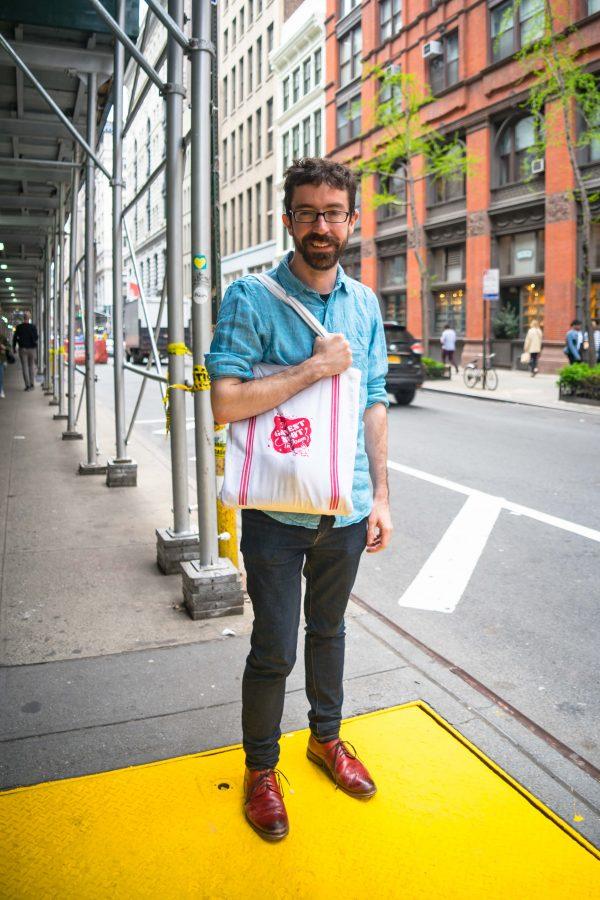What started as a pop-up museum in part-time NYU curator Hugh Ryan’s Bushwick loft eventually transformed into a quest to uncover Brooklyn’s queer history. The pop-up was expected to be a small kick-off event, but when over 300 people showed up, and the cops came to shut it down, Ryan realized he’d struck a nerve.
Earlier this year, Ryan published his new book, “When Brooklyn Was Queer,“ and he recently helped curate “Violet Holdings: LGBTQ+ Highlights from the NYU Special Collections,” an exhibition now on view in the Mamdouha Bobst Gallery, and “On the (Queer) Waterfront,” a show now on view at the Brooklyn Historical Society.
The pop-up museum was born out of retaliation against the removal of a video piece by the late queer artist David Wojnarowicz from the show “Hide/Seek: Difference and Desire in American Portraiture” at the Smithsonian in 2010. Outcry from conservative groups over depictions of Jesus and male nudity led the museum to remove the film.
“Almost overnight, that film, ‘A Fire in My Belly,’ suddenly, that was everywhere,” Ryan said. “Which was sort of amazing on one hand, but then the more I thought about it, the more I realized we all were protesting the removal of this one video, but I couldn’t go anywhere in New York and see queer films or queer content in major museums.”
The group, which came to be known as the Pop-Up Museum of Queer History, eventually settled on a model based around community-created shows about local queer history; Ryan’s group would assist with curation and help bring in outside pieces.
“People kept asking me, ‘What are you doing next?’ and ‘When’s the next one?’ and I hadn’t really planned beyond that,” Ryan explained. “So we very quickly formed this sort of ad hoc committee of people that wanted to be a part of the pop-up museum and we tried to figure out what it meant and what it was we were doing.”
The museum went on to do shows in Manhattan and Philadelphia before deciding to return to Brooklyn. Deciding to hold a one-day outdoor version of the show is what kicked off Ryan’s research into Brooklyn’s queer history.
“When we put out the call for proposals, unlike a lot of the localities we worked in, there weren’t a lot of people who knew about Brooklyn’s history,” Ryan said. “That was crazy to me, and that ticked me off to do research. It wasn’t meant to be a book at first, it just kind of expanded to there.”
Ryan’s research at first consisted of interviews and conversations. His initial findings came from tidbits of information he’d collect from talking to historians and book-lovers. It was during this time that Ryan continued his research on the history of queer Brooklyn independently, realizing there was enough there for a book.
“There were a lot of things I discovered about Brooklyn in that early period that I didn’t expect,” Ryan said. “One of the things I was really excited about was that it would be a really diverse history. It was a shock to me that between the end of slavery and 1940, Brooklyn was never less than 97% white. Whiter than Manhattan and more racist than Manhattan.”
Much of Ryan’s focus is on the erasure of Brooklyn’s queer history specifically, kicked off largely by the culture of homophobia in the 1940s ushered in by the postwar rise of conservativism. Along with suburbanization and changes in transportation, the waterfront economy in Brooklyn tanked. The Brooklyn waterfront was integral to the livelihood of many working-class queer people and its downfall contributed to this erasure.
“My book ends in 1966. There are so many stories that come after,” Ryan said. “I think there’s a whole book to be written about the lesbian community in Park Slope and a book to be written around the black gay bars or the trans drag performance scene that’s happening right now in the Village.”
The New York Public Library gave Ryan a grant which funded three months of full-time research. By the end of the three months, Ryan had his book proposal together. The rights to the book were bought in 2017 by St. Martin’s Press. “When Brooklyn Was Queer” was published in March of this year to extremely warm reception. Ryan went on to speak on panels and partake in book readings. Coinciding with the release of the book, the Brooklyn Historical Society is showing an exhibit curated by Ryan on the queer history of the Brooklyn waterfront; an exhibition of pieces from NYU’s Special Collections highlighting New York City’s LGBTQ history, which Ryan curated as part of NYU’s Stonewall 50 celebration, is now on display in the Bobst Gallery.
It was at these readings that Ryan came to fully understand the importance of the stories he was relaying to the community. People came up to him to relate their own experiences or stories they’d heard from family and friends about queer Brooklyn that had gotten lost in history.
“One guy the other day was telling me that his first boyfriend when he moved to New York was a guy from Brighton Beach who was from an Orthodox Jewish family,” Ryan said. “He would go down to Coney Island in the 1930s to pick pennies out of the sand and use them to play games at the boardwalk amusements. He would hook up with sailors on the boardwalk. These are amazing stories that are told orally only and you can’t catch them in the records anywhere.”
“When Brooklyn Was Queer: A History” is in bookstores now.
“Violet Holdings: LGBTQ+ Highlights from the NYU Special Collections” is on view in the Mamdouha Bobst Gallery, 70 Washington Square S., Manhattan, through Dec. 31.
“On the (Queer) Waterfront” is on view at the Brooklyn Historical Society, 128 Pierrepont St., Brooklyn, through Aug. 4.
A version of this article appears in the Monday, April 22, 2019, print edition. Email Aashna Agarwal at [email protected].


























































































































































